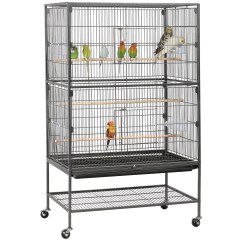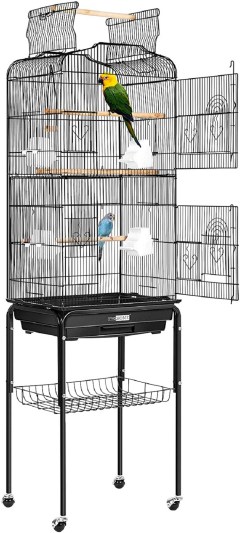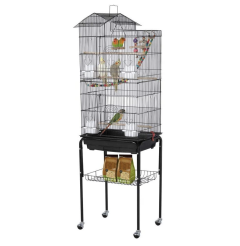
This large and sturdy cage is easy to assemble, moves smoothly, keeps your birds safe, and provides them with room to play and fly.
This large and sturdy cage is easy to assemble, moves smoothly, keeps your birds safe, and provides them with room to play and fly.
Very solid, strong, and secure. Made with water- and rust-resistant material. Easy-to-clean, removeable bottom. Durable, secure latches. Simple assembly. Roomy enough to hang plenty of toys in. Wheels on bottom to easily move around.
Smaller birds can squeeze through the wide bars.

We love this option for its open or close-top capabilities—ideal for active birds who can roam freely around the house but desire a safe, secure space in times of rest.
We love this option for its open or close-top capabilities—ideal for active birds who can roam freely around the house but desire a safe, secure space in times of rest.
Stands 64" tall and 18" wide. Open-top design allows freedom for energetic birds with ability to close at night or when away from the home. Includes 4 wood perches and a storage tray underneath. Rolling base for ease in transport.
Plastic base isn't as sturdy as some would like. Takes time to assemble.

This dual-doored cage will help provide your small or medium-sized birds with a high-quality life full of space and entertainment.
This dual-doored cage will help provide your small or medium-sized birds with a high-quality life full of space and entertainment.
Built with 2 doors, a slide-out tray, and a play area on top. A storage shelf, 4 perches and feeding cups, and a swing are included. Easy to put together. Strong base and bars. Tall and roomy. Saves space.
Some received the product with the doors or walls misaligned.

This sizable cage includes playful accessories for active birds that appreciate the stimulation of toys.
This sizable cage includes playful accessories for active birds that appreciate the stimulation of toys.
Features a large front door with easy access for cleanings or feedings. Includes wooden perches, chewing toys, swing, and colorful climbing ladder. Slide-out tray base is convenient for cleaning waste. Cage rolls on 360-degree swivel wheels.
Cage consists of 2 separate parts that stack and need to be secured by the owner. Otherwise, the unit isn't very sturdy.

We recommend these products based on an intensive research process that's designed to cut through the noise and find the top products in this space. Guided by experts, we spend hours looking into the factors that matter, to bring you these selections.

Cockatoo, canary, budgie, or finch, your feathered pet is a member of the family. After clean water, the right diet for their species, and your love and attention, the most important thing you can give them is a space to call their own.
Every pet bird needs a safe spot where it can feel secure – and where you know they're not going to get into mischief. For just about every bird owner, that means a bird cage.
Choosing the right cage is crucial to your bird’s well-being. Unless you intend to use the cage purely for decoration, not to house a pet, a bird cage needs to suit its inhabitant’s needs and meet your requirements for space, appearance, and ease of care.

There are lots of bird cages available, but most fall into one of the four following categories.
This is probably what you picture when you think of a bird cage. Generally rectangular, you’ll find a wide range of classic bird cage sizes, from short and wide to tall and narrow. In general, these cages are smaller than flight cages.
These cages are basically flight or classic cages with a top dome instead of a flat ceiling. This gives your bird more space to move around, and it’s a bit more attractive, to boot.
Aviaries, also called flight cages, are large cages with plenty of room for larger birds to move around and spread their wings. That said, even small birds need space for exercise. If you have enough room, this is a good cage style for most pet birds.
A playtop cage is a great way to let your bird enjoy some freedom outside his cage. These bird cages have a “playground” on top. The playground generally consists of one or more perches as well as food and water dishes. If you trust your bird not to try to escape, a play-top cage can be fun for both of you.




















The two most important factors in choosing the right cage for your pet bird are cage size and the spacing between the bars.
Whatever your type of pet bird, he should be able to fully spread his wings inside his cage, move around both horizontally and vertically, and stretch out his tail and any head feathers without restraint.
A cage that is too small is very distressing for a bird. It can lead to undesirable behaviors such as screeching, feather plucking, biting, or refusal to eat. The larger the bird, the larger its cage needs to be. In fact, there really is no cage that is too big as far as your bird is concerned, so go ahead and get the biggest cage that fits your space.
“Bar space” refers to the distance between cage bars. Birds can squeeze through surprisingly small spaces and are excellent escape artists. It’s crucial that you choose a bird cage with bars spaced appropriately for your pet. Otherwise, he’s at risk for escaping or sustaining an injury when his head or foot gets stuck between the bars.
Small birds: The smallest birds, such as finches, lovebirds, and canaries, do best in a cage that’s a minimum of 24 inches wide, 24 inches deep, and 24 inches high. This gives them enough space to move around, flit from perch to perch, and spread their wings. The bars should be no more than 1/4-inch to 1/2-inch apart.
Medium birds: Medium-size birds, including conures, cockatiels, and Senegal parrots, are happiest in a cage that’s a minimum of 24 inches wide, 24 inches deep, and 36 inches high. The bars should be no more than 1/2-inch apart.
Medium-large birds: Medium-large bird species, such as caiques and red-fronted parrots, require the same minimum cage size as medium-size birds. However, the bars can be slightly farther apart; a distance of 5/8-inch to 3/4-inch is generally acceptable.
Large birds: The largest pet birds, including macaws, African greys, and cockatoos, need correspondingly large cages to remain happy and healthy. At a minimum, these birds need a cage that is 36 inches wide, 36 inches deep, and 48 inches high. These big birds need bars no more than 1 to 1 1/2 inches apart to prevent escape or injury.

Once you’ve decided on a basic style and size, there are other features to consider before choosing your feathered friend’s new home.
A bird cage made of welded stainless steel stands up to all the punishment your bird can dish out: chewing, pecking, flapping, and other common bird behaviors. Stay away from plastic or wooden cages, which many birds can chew or peck through.
Feeder doors let you provide clean water and fresh food to your pet quickly and easily.
Many birds are capable of picking their cage lock, so a sturdy latch that’s beyond your bird’s ability to open is a must. Depending on the cage, the latch might be a tension pole, a sliding bar, or a hinge lock. If your bird is especially clever, you’ll want to add an additional lock to the door.
The cage access door needs to be large enough to fit your entire arm – you’ll be reaching inside the cage to clean it, after all – and comfortable enough for your bird to get through without squeezing, catching feathers, or bumping a flapping wing.
Just about every cage these days has a slide-out litter tray for convenient cleaning; don’t even consider a cage without one.
Birds are messy eaters, so it’s helpful for the cage to have a seed guard. These plastic shields help keep seeds, fruit, shed feathers, and bird droppings inside the cage and off your floor or nearby wall.
Every bird needs at least one perch, although it’s even better to have two or more. Natural wood or small branches are best, as they encourage natural movement of your bird’s feet.
Many cages include food and water dishes or trays. These should be sturdy enough to withstand chewing and pecking, especially if you have a parrot or other large bird. Stainless steel or ceramic are best for large birds, but plastic is suitable for a smaller pet.
To keep your feathered family member happy, both he and his cage require daily care.
Each day, clean all food and water bowls and refresh the contents. Wipe away any droppings on the cage or its accessories, and change the substrate or paper flooring.
Weekly, remove the entire litter tray and grate, and wash it in soap and water or bird cage cleaner. Clean your bird’s perches and toys, as well.
The entire cage needs monthly cleaning. Let your bird enjoy his playground or a backup cage while you thoroughly clean his primary home with soap and water or commercial cage cleaner. Use a scrub brush to remove any particularly stubborn or dried droppings, and make sure to thoroughly clean the edges and corners of the cage. Let it dry completely before returning your bird to his home.
With such a wide range of sizes, styles, and shapes, you’ll find an equally wide price range when it’s time to choose a bird cage.
While you’ll find small bird cages for under $40, these tend to be lightweight and not large enough for most birds bigger than a finch to flit around, stretch out their wings, and move from perch to perch. Inexpensive cages are okay for travel or to house your bird while you clean his primary cage, but they typically aren’t sturdy enough for everyday use.
You’ll find decent basic cages for small or medium birds for $60 to $100. If you want a bird cage with a play top or dome, however, be prepared to spend more.
A large bird cage of good quality will cost over $100. In fact, it’s not unusual to find cages selling for several hundred dollars. At the top of the price range, you’ll get a large, sturdy cage with an equally sturdy stand, all the features that make both you and your bird happy, and a nice accessory package.

A. Most birds enjoy having toys in their cages. Mirrors, bells, blocks of wood for chewing, swings, and rope toys can provide hours of fun for your feathered friend.
A. Birds can be delicate, so the decision on where to put the cage is an important one. Keep the cage away from direct sun or intense heat, but also avoid drafty spots, areas too near the kitchen or any other location prone to gas or chemical fumes, and anywhere other household pets might bother your bird. Generally, a spot in the living or family room is ideal.
A. You’ll find cages in many different shapes, including square, rectangular, circle, and even pagoda-style shapes. While some angles to the cage give your bird a variety of areas to hide when he feels insecure, remember that the more angles there are, the more difficult it will be to clean the cage.
Some bird specialists caution that round cages are not really suitable, as they don’t give the bird a reference point for location or a sense of security, leading to psychological distress. For the most part, a rectangular cage is the easiest to clean and find accessories for, and many agree that it keeps birds the happiest.
Get emails you’ll love.
Learn about the products you’re wondering if you should buy and get advice on using your latest purchases.
